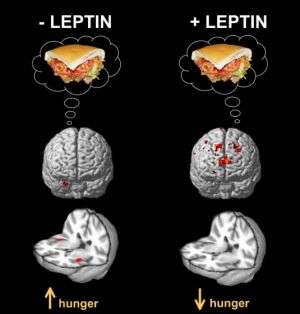Researchers identify the brain circuits that control hunger

Researchers at UCLA have identified the brain circuits involved in hunger that are influenced by the hormone leptin, the signaling molecule produced by fat cells. In clinical trials, leptin supplementation has produced moderate weight loss in some obese patients by inhibiting hunger and promoting feelings of satiety. The new findings suggest possible new therapeutic targets for obesity, an increasing problem in both adults and children.
Reporting in the Oct. 29 online edition of Proceedings of the National Academy of Science, Edythe London, professor of psychiatry at the Semel Institute for Neuroscience and Human Behavior at UCLA, Kate Baicy, a graduate student in London's lab, and colleagues report that leptin reduces activation in regions of the brain linked to hunger while enhancing activation in regions linked to inhibition and feelings of being full.
The researchers used functional magnetic resonance imaging (fMRI) to measure brain activity before and after leptin supplementation in three adults from a Turkish family who lack the leptin (ob) hormone due to a mutation. Such a mutation in the ob gene causes leptin deficiency and morbid obesity.
The study involved only three subjects, London said, because "having a genetic deficiency in leptin is extremely rare. We were fortunate in finding them."
Indeed, research published in 2005 by Dr. Julio Licinio, then a researcher at UCLA, used the same three family members to show that when leptin replacement was provided, body weight and eating behavior were normalized. Also in 2005, London and her team showed that leptin produced sustained changes in the tissue composition of the cerebral cortex in the same individuals.
To determine the neural circuits through which leptin alters human feeding behavior, the researchers showed images of food to the family members while they underwent fMRI imaging, both before and after leptin treatment. After leptin replacement, feelings of hunger induced by the images and activity in certain brain regions associated with hunger — the insular, parietal and temporal cortices — were reduced, while brain activity increased in the prefrontal cortex, an area of the brain previously associated with feeling full or satisfied.
London said that despite the limitations of having only three subjects with the ob mutation, "we think knowing the mechanisms by which leptin alters brain function in congenital leptin deficiency can provide understanding of normal leptin physiology. Ultimately, that may help identify new targets for the treatment of obesity and related metabolic disorders."
The research was supported in part by the National Institutes of Health and the UCLA General Clinical Research Center. During the course of this study, Amgen Inc. graciously provided leptin; Amylin Inc. now provides leptin to these patients. Neither Amgen nor Amylin contributed to the design, analysis or writing of this study.
Other authors involved with the study were John Monterosso, Tuncay Delibasi and Anil Sharma of the Semel Institute and the David Geffen School of Medicine at UCLA, and Ma-Li Wong and Julio Licinio of the University of Miami Miller School of Medicine.
Source: UCLA





















